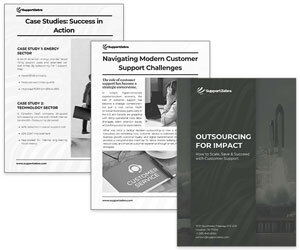This article focuses on how to retaining staff and keeping them happy. It is the second strategy presented in our article: The Top 10 Customer Service Strategies
The late, great customer service and contact expert Paul Cooper wrote this article for us and, to this day, his ideas still have great relevance, across both industries.
Do Happy Staff Really Make for Happy Customers?
The key to contact centre success often lies in getting new staff off on the right foot, so that you keep them, reduce headcount turnover, improve morale and job satisfaction.
The first thing to emphasize is that these points are intrinsically linked.
Thinking this through, the first thing to emphasize is that these points are intrinsically linked.
As a Gallup report once found, companies in the upper half of both customer and employee engagement get a 240% boost in bottom line results.
So, let’s start a simple exercise. Just put yourself in the place of a new starter to your organisation: a little nervous perhaps, into the unknown…
First Impressions
To begin, what kind of a first impression does your organisation present?
Perhaps the new recruit has already gone on your website to get a good idea of what’s to come. Does that create the welcome you want to show? Go have a look.
Then, what about actions you could have done before they start – pre-reading perhaps, site maps, directions, details of joining, etc?
What about actions you could have done before they start – pre-reading perhaps, site maps, directions, details of joining, etc?
This is the perfect time to get a new recruit excited about working for you, talking to parents, relations, and others.
If you are in an appropriate business, what about getting them to try your products and services, experience stores, and your competition, looking to get them to change their products to yours? They might also get others around them to change habits too.
Then, there is that first-day arrival.
- Is there an appropriate reception?
- Do your people know they are coming?
- Is there a welcome?
- Did you have a security pass ready for their first day at work?
- Is there material to get them interested?
- What about a few questions relating to the points above – did they enjoy checking you out?
- What is the training plan?
I’m sure you can see many more ideas where you can make a great first impression, which could last a lifetime.
For more ideas on how to welcome new recruit into the contact centre, read our article: 8 Ideas to Welcome Your Advisors on Their First Day at Work
What Are They Going to Say to Their Families When They Go Home?
This is a critical sign of how they will then continue working. An investment in that first day, and the first week, will pay huge dividends in developing a positive staff attitude to you, and your organisation.
- Have they had the opportunity to mix with existing staff, meet management, settle in?
- Do they know their job role and where/how they fit into the organisation?
- Did you encourage them to ask questions?
- Do they have a clear idea of their initial training/induction?
- Have you identified any areas of relative weakness that might need working on?
All these issues, which can be covered over the first few days, will reduce the period of strangeness for the new employee, and give you a much better idea of their strengths, weaknesses and potential.
Investing the time at this stage can save months of problems and work later.
Good Mentoring and Coaching
Over the last ten years, it has become very clear that, whilst formal training still has its place, more is often achieved by good mentoring and coaching by experienced and committed supervisors and managers.
Staff development is not a subject that can be delegated to HR departments, however good. Of course there is a need for them to be involved in making sure that standards are met across the organisation, and the right actions actually taken, but staff are the direct responsibility of line management.
In fact, development of their team is the primary responsibility if they want to achieve long-term success.

Paul Cooper
This induction period is probably the single most important time for creating the culture and long-term morale of an organisation’s staff. It is too often neglected, skipped over, or misunderstood.
Personal involvement by senior staff, and direct managers, is well worth the time and effort.
This article was written for us by Paul Cooper a valued and not-forgotten member of customer service and contact centre industries.
Read the next three articles in the series by following any of the links below:
- Top Customer Service Strategies – No. 3 Recognise the Importance of Customer Loyalty
- Top Customer Service Strategies – No.4 Lead from the Top
- Top Customer Service Strategies – No.5 Listen to Your Customers and Staff
Author: Jo Robinson
Published On: 4th Apr 2012 - Last modified: 25th Mar 2020
Read more about - Customer Service Strategy, Customer Service, Morale, Motivation, Retention, Top 10 Strategies





















In light of today’s economic setting, it’s more important for companies to have happy and productive employees. Your business is only as successful as its staff; therefore, it is of utmost importance that you develop a positive work culture in your business.
Happy employees are any business’ best asset. However, keeping them happy in any economy is hard work. If the workplace is stressful, employee production goes down. Happy employees are satisfied and feel a sense of accomplishment in their work. They like themselves and what they do, and find satisfaction from their work. The best employees prefer to work for companies that provide the type of exceptional value that creates customer loyalty, thus, creating loyalty has become the toughest test for leadership in Philippine call center. Great customer service depends on the people providing that service. They have to be willing to serve well. They have to be inspired to go beyond what is their responsibility, in other words, they have to be treated well. When workers feel that they are a dynamic and essential part of the team, they are more productive and willing to go the extra mile for customers and co-workers. A positive work environment is critical no matter how many employees you have. Therefore, give praise openly, set goals appropriate to the work, and always take your employees’ needs seriously. It is management that fosters the work atmosphere so they are responsible for conducting things in a way that helps raise people’s spirits.
We are one of those BPO companies which has a “fiesta” atmosphere and enjoyable to work in. They deliver a program that is tailored to suit each client providing them with multiple service strategies, analytical reports, networking connection and security, integrated with high-level training modules for call agents and staff.
A company will have strong customer service if it has strong leadership, and the commitment that this leadership conveys. When you have a happy and productive workforce that is eager to contribute, your company can weather any storm.
So true! But we cannot forget that Happy employees = Happy customers = Happy profits, and in real life the last part of this statement is the most important for the employers! So by accessing higher levels of discretional efforts in their employees, employers can improve the service delivered to customers and in so doing, improve the operational performance of the business.
I think that in all those tips there is one missing: gamification as a part of motivating and engaging employees. There are indeed some studies on this topic. Not to mention that inter-team competitions are very likely to increase performance of the whole CC centre!